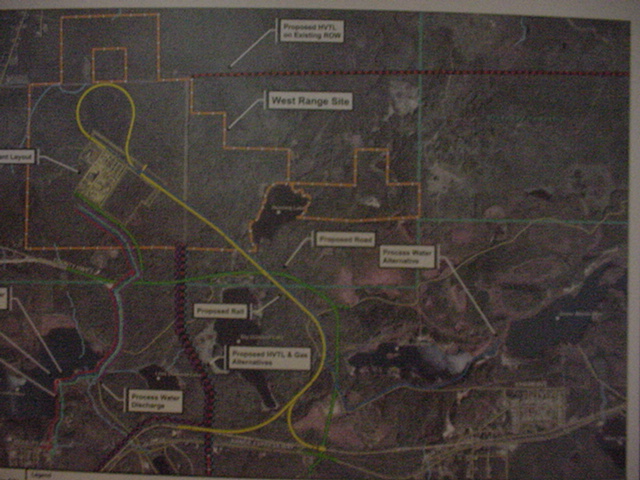Mesaba – Comments on Scope of EIS due November 14
October 28th, 2005
Comments are due on the Scope of the EIS by November 14, 2005. Here’s the DOE’s Notice of Intent: Download file
Send to:
Richard Hargis
M/S 922-342C
U.S. DOE – NETL
P.O. Box 10940
Pittsburgh, PA 15236-0940Email to:
richard.hargis@netl.doe.gov
Fax to:
(412) 386-4775
I have to approach this project with humor, because it is so damn absurd that it went forward, and now that it’s going forward in a greenfield — what’s wrong with this picture. It’s so bizarre that those with the resources and who oppose coal plants were silent as the largest coal plant, the largest power plant of any type, in the history of Minnesota rolled through the legislature, and remain silent today. Is this the energy future we want?
Look again at this view of the coal train route on the other side of the lake! The plant would be way off to the left. This is the energy nightmare moving towards reality.

The site maps are here. They’re not on the Excelsior site. Click here to ask them to post information!
Here’s my notes from their Power Point — handouts on this project only go one way — I had to take pictures of them!

Phase II
Construction of Phase II IGCC power station overlaps
construction of Phase I station
* Resource requirements, emissions, effluents and byproducts
double in most instances
* 160-180 permanent, full-time staff (Phase I+II)
* Increased water demands
o Sufficient water supply must be demonstrated
o Use of additional water sources likely
* Commercial in-service planned for 2013Public Utilities Commission
* Phase I construction: Q3 2007 � Q4 2010
o 1,000 construction workers on-site at peak + vehicles
o 25 acres of land required for IGCC plant; additional 80
acres required for equipment laydown plus 5 acres for
concrete batch plant
* Phase I operation: Q4 2010 � onward
o 100-120 permanent full-time workers* Resources consumed & by-products generation: Estimated worse
case
o Coal 8,230 tons of coal per day: 4-5 round-trip unit train
trips per week
o Water 6,500 gallons per minute peak 4,500 gallons per
minute annual avg.
o Marketable byproducts: 500-800 tons/day slag; 30-160
tons/day elemental sulfur
o Materials for disposal: 2,200 tons/yr ZLO salts; 75 tons/yr
carbon
o Very low emissions of air pollutants, including mercury
___________ year)
* No discharge of process waters used to clean syngas on _______
* West Range site flood control
* Water used for evaporative cooling discharged to Holman Lake
(West Range)
* Four year search effort
* Criteria utilized to narrow list of potential sites
o Licensability
o Community support
o Sufficient water supply for Phase I & II developments
o Access to infrastructure sufficient to meet project needs
– Optional rail providers
– Existing corridors to reach major electric
substations(s)
o Site control
o Lake Superior Basin watershed
* Ongoing investigations
Note the above says “Lake Superior Basin watershed — this is not correct for the West Range – Taconite site — it’s in the Mississippi, where the Swan River and Mississippi are already listed as impaired. Check the PCA’s map!
Here’s the info from the meeting from the feds, called Mesaba Energy Project. Download file
Here’s the new map or site plan, note the green line between the two lakes — that’s new, a landowner discovered Co. Rd. 7 would be rerouted over his land at the meeting — no one had bothered to contact him.

Here’s a drawing of what it might look like — remember, everything is preliminary and changable:

And here’s a more schematic view from above:

Here’s the DOE-Notice of Intent with more info on the project than we’ve ever received before: Download file
And I noticed a tie that should be clarified. Ron Dicklich, in his “we NEED this power,” “we’ll freeze in an incubator in the dark without a job” project stump speech, declared that he “works for GRE and Range Association of Municipalities and Schools,” but there’s more:
What he neglected to say was that he’s also promoting MSI, which is to be located in Nashwauk, and which is planned to share rail infrastructure with the Mesaba Project — and perhaps an electrical customer — can MSI be built without the ready supply of electricity? Here’s the info on the MSI tie that should have been disclosed:
MSI outlines $1/6 billion dollar project
MSI project moving forward
I hate it when people hide their vested interests…
This is the same Mesaba and MSI connection that Miles W. Lord is concerned about.
Leave a Reply